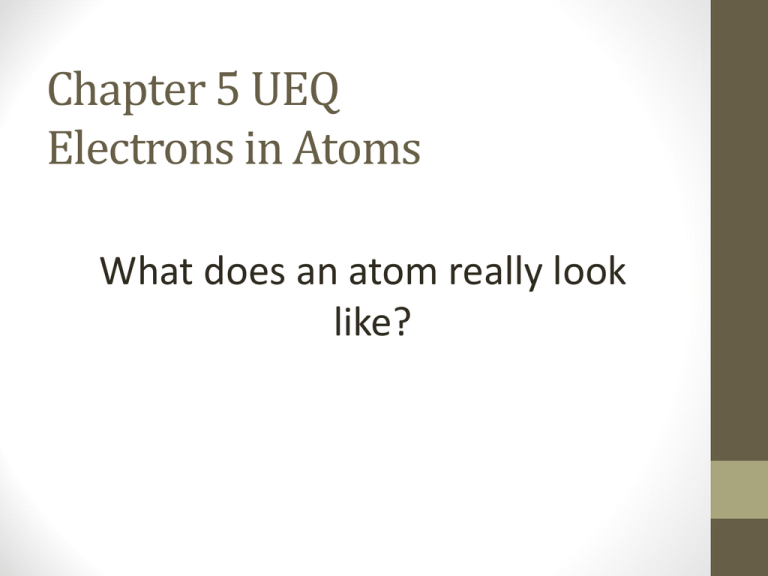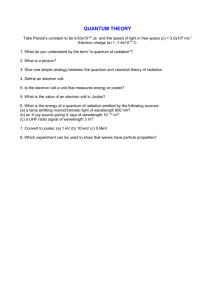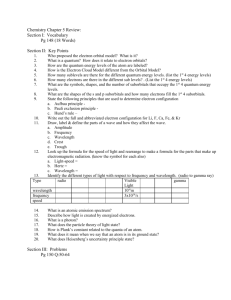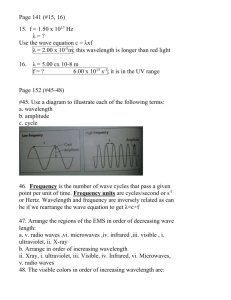Chapter 5 Lecture Notes
advertisement

Chapter 5 UEQ Electrons in Atoms What does an atom really look like? LEQ Why is the study of light used to describe electron arrangement? Quantum Mechanics: A view of the atoms defined in terms of wave behavior and wave probability. Transverse wave: wavelength, frequency and amplitude. Electromagnetic radiation: energy that travels in a wave-like pattern and is defined by: c = λf Speed of Light: c = λf c is the symbol for the speed of light. - this is a constant for all electromagnetic radiation. - c = 3.0 x 108 m/s λ is the symbol for the wavelength - the distance between two equivalent points on a transverse wave. - expressed in (m), (cm), or (nm) f is the symbol for the frequency of a wave. - this is how often the wave occurs - expressed in hertz (Hz) meaning cycles per second Relationship in c = λf λ and f are inverse to each other: if the wavelength gets longer, the frequency will get smaller. Remember the ‘c’ is a constant for all electromagnetic radiation. 3.0 x 10 8 m/s Planck’s Constant Quantum: the minimum amount of energy that can be gained or loss by an atom. Equantum = hf or Equantum = hc λ • Planck’s constant 6.626 x 10-34 j-s times the frequency of the wave is the quantum energy. • 1 photon = 1 quantum of energy. Samplers 1. Orange light has a frequency of 4.8 x 1014 Hz. What is the energy of one quantum of orange light? ans: 3.18 x 10-19 J 2. Which is greater, the energy of one photon of orange light or the energy from one quantum of radiation having a wavelength of 3.36 x 10-9 m? ans: 5.92 x 10-17 J Sampler 3. A radio station emits radiation at a wavelength of 2.9 m. What is the station frequency in MHz. ans: 1.03 x 108 /s = 103 MHz 4. What is the wavelength of radiation emitted with a frequency of 4.3 x 1017 Hz? ans: 6.98 x 10-10 m 5. At a frequency of 3.44 x 1021 Hz, what is the wavelength? ans: 8.7 x 10 -14 m • The Electromagnetic Spectrum Gamma λ 10-14 Light 10-7 (fig 5.5) Radio 104 f 1022 1014 104 E 10-12 10-19 10-30 Electronmagnetic Spectrum LEQ •Why is the Quantum Model of the atom better than Bohr’s Model ? Quantum Mechanic Model Bohr’s Model: 1. electron occupy defined energy levels 2. electrons occupy from the lowest level to the highest level. 3. levels are differing distances apart 4. electron will not occupy between the levels. Quantum Mechanical Model: 1. electrons occupy regions that are defined distances from the nucleus 2. those electrons are not found in defined energy levels 3. electrons are found in areas within a region of highest probability. 4. electrons are found between the energy levels. From the lowest region to a higher region. LEQ What are the concepts that have been developed to give us a picture of the atom? Quantum Numbers Heisenberg Uncertainty Principle: p151 Principle Quantum Numbers (n) are the Energy Levels Sublevels: s, p, d, and f Orbital: s = 1, p = 3, d = 5, f = 7 Spin: + and/or – ½ Electron Configuration: Aufbau Principle: ‘to build’, lowest level to the highest level of energy. Pauli’s Exclusion Principle: electrons must spin in opposite direction to each other. Hund’s Rule: one in each before fill. One electron MUST occupy each orbital before another electron enters Quantum Mechanics • Electron Configurations • Valance configurations • Short hand notation • Diagonal Rule • Orbital diagrams • Orbital Shapes • Identify elements and/or position of elements based on configuration. • 2n2 maximum number of electrons in the principle quantum number. • Relative Stability Ground State Configuration • Valance Electron Dot Configuration • Diagonal Rule and the Periodic Table • Shorthand electron configuration









